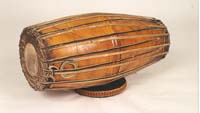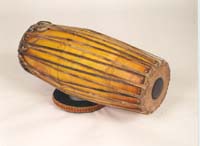|
Mridangam is characterized by a rich
and varied tone. Some strokes evoke clear pitched sounds while others
evoke unpitched sounds. The following discussion is based upon the pitched
strokes because they more clearly show the tonal differences.
The size of the mridangam is one of the important factor for the sound it
produces. The pitch of the mridangam varies according to its size. The
larger (Fig.1a) the mridangam, the lower the pitch and the smaller
(Fig.1b) the mridangam, the higher the pitch.
Rim Stroke (right hand) - The rim stroke is a major
stroke on the mridangam. Although the nomenclature varies, this stroke is
usually called "Na" in the North and "Nam" in the
South. On mridangam a predominant third harmonic is the main
characteristic (Fig. 2 a, b; below). However, the fundamental may be seen
in significant proportion in the mridangam while it is essentially absent
in the tabla. Furthermore the second harmonic tends to be evoked in the
tabla while it is suppressed in the mridangam.
|

|
|
|
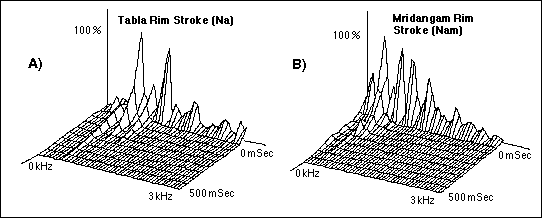
|
|
Open stroke (right hand) - The open stroke is also a major stroke
for both drums. This is called "Tun" in the North and
"Dheem" in the South. Both strokes are characterized by
a very prominent fundamental. However there is a significant
difference in the second harmonic (Fig. 2 c,d).
|
|
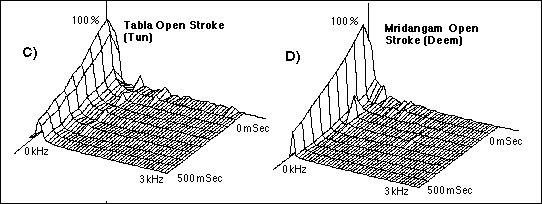
|
|
Open stroke (left hand) - The open stroke of the left hand is
called "Ga" in the North and "Thom" in the
South. It shows a tremendous difference between the two
instruments (fig. 2 e,f). It has been found that the tabla has a
very pronounced fundamental and a long sustain. There are much
fewer harmonics in this stroke. Conversely the mridangam has a
much more complex harmonic spectrum and a significantly reduced
sustain.
|
|
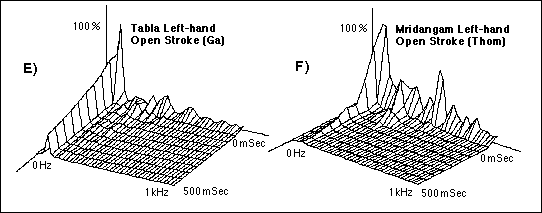
|
|
In order to know the physical and structural relation of the type
of skin used in making the instrument and the sound produced, the
cross sectional features of leather used in different instruments
were studied. In various skins horizontal fibres running
predominantly along the scales direction and the network structure
flows perpendicular to the scales direction.
In goat skins, there is no horizontal running of fibre bundles and
the fibres is in loose weaving. In sheep skin, the grain layer is
comparatively larger than that of goat skin and fine fibres
predominantly running along the hair follicles direction. The
cross sections are plain and compact in cow calf leather. The
fibres are glued together and from seperate blocks in all
directions.
The theory of circular membranes considers them as two dimensional
stretched strings. The fundamental frequency can be related as :
|
|
fo1 = 0.382 T
R õ
|
where,
fo1 = fundamental frequency
R = radius of the membranes
T = circumferential tension/unit length
(õ) = mass/unit area of the membrane
|
|
The pitch of the membrane, as in a stretched string depends on the
size and weight of the membrane and the amount of tension it is
under. The pitch lowers, as the size or weight is increased and
rises when the tension is increased. In the case of drums, the
sound produced by it depends on the resonator column and the
properties of leather, the loudness depends on the amplitude,
energy and the intensity.
|
|


